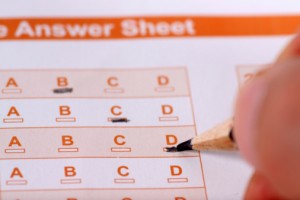Public School Math Doesn't Teach Students How to Reason
In New Jersey, which is where I grew up, there is a running argument over state funding for education. In the latest salvo, reported recently in the New York Times, a report by Judge Peter E. Doyne concludes that the state is not spending enough on the poorer school districts.
The monetary amounts, as too often happens, are reported in an almost meaningless form: as a total for the entire state. For example, the state budget for aid to schools is given as $10 billion (after I round off slightly). Is that amount large or small, or even reasonably likely to be correct? Who knows until it is turned into a human-sized number as spending per pupil. Combining this state funding, the local spending, and the federal contributions, New Jersey’s per-pupil spending turns out to be $17,620 per year.
This spending level is the highest in the country, which ranges from about $6000 (Utah) to $17620 (New Jersey). It is also a good fraction of a private-school tuition! Which started me wondering what we, the public, are getting in return for funding public schooling. I went to public school for all but two years. And I am shocked at what seems to be the main purpose of public schools today: practicing for and taking standardized, high-stakes tests.
In particular, where I now live it is Massachusetts Comprehensive Assessment System (MCAS) season. Therefore, the email newsletters that we receive from a public school in our city talk almost entirely about testing. We are urged to send our children to four Saturdays of test-preparation boot camp, and we are exhorted to write a “positive, heart-felt message giving your child encouragement and support to show us [on the tests] how much he/she has learned this year.”
Maybe this test obsession will be okay if the tests themselves are good. Ever hopeful, I studied an MCAS test’s mathematics section. Alas, the questions do not even resemble mathematics. For me, mathematics is about exploring patterns and using numbers and quantitative relationships to understand how the world is put together. However, the MCAS test is to mathematics as disconnected notes are to a symphony.
For example, here is the first part of a 2010 MCAS question (Question 42 on page 57 of the “March 2010 retest items”):
A small box of snack mix weighs 18 ounces and costs $4.32.
a. What is the cost per ounce of the snack mix? Show or explain how you got your answer.
The snack mix is also available in a large box that costs $6.60. The large box has a cost of $0.22 per ounce.
b. How many ounces does the large box of snack mix weigh? Show or explain how you got your answer.
This question only seems like mathematics. First, the large box’s information is given in an absurd form. I have never seen a box of snack mix, cereal, or anything that gives the price per ounce but not the number of ounces! Second, as a mathematician, if I had to compare the cost effectiveness of small and large boxes of mix, I would never compute the cost per ounce. Not only is dividing by 18 painful, it is pointless: I would instead compare the costs using proportional reasoning, for that method emphasizes relationships.
To make the comparison, I’ll rewrite the large-box portion of the question to be realistic:
A large box contains 30 ounces of snack mix and costs $6.60 [thus costing $0.22 per ounce, as in the original question]. How much extra am I paying, per small box of snack mix, if I buy my mix in small rather than large boxes?
Time for proportional reasoning. The small box (18 ounces) has 60 percent of the weight of the large box (30 ounces). Thus, if both boxes had the same price per weight, the small box should cost 60 percent of the large box.
Sixty percent of the large-box cost ($6.60) is $3.96: 50 percent would be $3.30, to which I add 10 percent, or $0.66, to get $3.96. Thus, at large-box rates, the small box would cost $3.96. In reality the small box costs $4.32, which is $0.36 more than it would cost at the large-box rate. With that information I could decide whether the small box’s convenience justifies its extra cost (for example, by being less likely to go stale before I finish it).
The mathematical method of proportional reasoning is simple and direct. Most importantly, it emphasizes the relationships (here, in size and price) between the boxes. Building connections and relationships is at the heart of deep understanding. That is why proportional reasoning is crucial in fields as diverse as physics, engineering, and biology (where it explains, for example, why large animals need circulatory systems).
A powerful, general mode of reasoning is just what mathematics can and should offer to the world. In contrast, the high-stakes tests’ offer what American physicist Richard Feynman might have called cargo-cult mathematics. They use numbers and mathematical operations, they look like mathematics, but the substance is missing. By teaching to these tests, we are teaching students disconnected notes and calling it a Bach fugue.


Comments